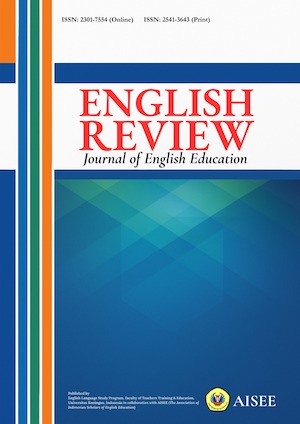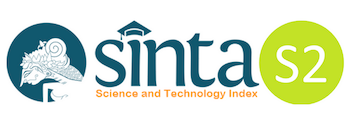PRONUNCIATION VARIABILITY OF ENGLISH DENTAL FRICATIVES AMONG SUNDANESE LEARNERS IN DIFFERENT ACADEMIC DISCIPLINES
Abstract
Clear pronunciation is a critical component of successful communication, essential for developing both speaking and listening skills. However, pronunciation challenges often arise due to differences between written and spoken forms of a language, as well as the influence of a speaker's native language. This study examines the production of English dental fricative consonant sounds by Sundanese students from English and non-English departments at Widyatama University, Indonesia. The study aims to identify common pronunciation errors and their causes, comparing students who have extensive English training with those who do not. A qualitative descriptive method was employed, supported by content analysis, to analyze the pronunciation of 10 students—five from each department. The findings reveal significant differences in pronunciation accuracy between the two groups, with English Department students generally performing better. Common errors include the substitution of dental fricatives with alveolar stops and labiodental fricatives with bilabial plosives. The primary causes of these errors are attributed to insufficient practice, lack of phonetic awareness, and interference from the native Sundanese language. This research highlights the need for targeted pronunciation training and increased phonetic awareness to improve English pronunciation skills among non-English majors.References
Aji, H. P. A., Widodo, S., Masykuri, E. S., & Nugraheni, I. I. (2023). Students’ problems in building up english vocabulary. Scripta: English Department Journal, 10(1), 44-58.
AlSaqqaf, A., Xin, Z., & Sharif, S. (2023). Investigating self-concept in EFL pronunciation among Chinese non-English major learners at a public university in China. International Journal of English Language and Literature Studies, 12(2), 117-129.
Amalia, D., & Amin, M. (2023, December). Students’ awareness in coping with pronunciation problems: a study among the second semester students of english department FKIP at university of Mataram. Journal of English Education Forum, 3(2),12-17.
Ambalegin & Arianto, T.. (2018). English vowels and consonants mispronunciation of the seventh president of the republic of Indonesia in his official English speeches and its influencing factors. language literacy: Journal of Linguistics, Literature, and Language Teaching, 2(2), 111-125.
Ambalegin, A., & Afriana, A. (2023). How to perform English word stress on English pronunciation. Anaphora: Journal of Language, Literary, and Cultural Studies, 6(1), 14-27.
Annisa, A., & Wariyati, W. (2023). Speaking challenge, does pronunciation as the attribute of fluency? Journey: Journal of English Language and Pedagogy, 6(2), 356-365.
Babajanova, K. I., & Babadjanova, N. X. (2023). Challenges and possible solutions of teaching english pronunciation as a second language in uzbek classes. Academic Research in Educational Sciences, 4(3), 459-465.
Benjamin-Ohwodede, J., Mamudu, A., & Awunor, S. N. (2024). The effectiveness of hybrid learning in english pronunciation pedagogy in the Nigerian ESL context. Jelita, 5(1), 81-103.
Emmanuel, A, Bright Oppong-Adjei & Adjei, P. Y., Okrah, E. K (2022). The uniqueness of Ghanaian English pronunciation: Analysis of dental fricative sounds. European Journal of Literature, Language and Linguistics Studies, 5(4), 114-132.
Fernández, L. C., Gapper, S. E., & Morales, H. S. (2024). A comparative approach for pronunciation instruction in English. Letras (76), 67-101.
Haris, K., & St Asmayanti, A. M. (2023). Problems related to the learning of english pronunciation at the first year students of english department Universitas Muhammadiyah Makassar. Journal of Language Testing and Assessment, 3(1), 77-87.
Hoang, N. T., Han, D. N., & Le, D. H. (2023). Exploring Chatbot AI in improving vocational students’ English pronunciation. AsiaCALL Online Journal, 14(2), 140-155.
Khoshmuratovna, K. M. (2023). Common pronunciation problems that ESL and EFL students face. Golden Brain, 1(12), 118-125.
Kurniawan, A., & Thren, A. T. (2024). The influence of the mother tongue on English pronunciation: A case study on Indonesian EFL learners. Journal of English Teaching, 10(1), 61-75.
Kusuma, C. S. D. (2018). Integrasi bahasa Inggris dalam proses pembelajaran. Jurnal Efisiensi – Kajian Ilmu Administrasi, XV(2), 43-50.
Lestari, R., Harahap, A. L., Munthe, D., Rusli, M., Rambe, S. A., & Harahap, N. (2024). The improving of students English pronunciation skill by using English pronunciation digital at man Labuhanbatu, Sumut. Journal on Education, 6(2), 14797-14809.
Luthfianda, S., Irawan, Y., Rahayu, R., & Hidayat, S. (2024). Exploring pronunciation challenges: Indonesian university students' production of English fricative sounds. English Review: Journal of English Education, 12(1), 85-94.
Manurung, L. W., Saragi, C. N., & Sitinjak, A. S. (2024). Diagnosing the English department students' English vowel and consonant pronunciation errors by using elsa speak application. Innovative: Journal of Social Science Research, 4(1), 3673-3686.
Mesfer, F., Yahrif, M., & Siradjuddin, S. (2024). An error analysis of undergraduate students’ English pronunciation. Edulec: Education, Language, and Culture Journal, 4(1), 79-93.
Nguyen, T. N. (2023). An investigation into difficulties in teaching pronunciation to first-year english majors at dong nai university. Journal of English Language Teaching and Applied Linguistics, 5(2), 135-150.
Nirwana, N., & Suhono, S. (2023). Phonological interference in English pronunciation produced by students at senior high school: A case study of Buginese and Javanese students. Anglophile Journal, 3(1), 1-13.
Octaviani, R. P., Jannah, L. M., Sebrina, M., & Arochman, T. (2024). The impacts of first language on students’english pronunciation. International Journal Of Indonesian Education and Teaching 8(1), 164-173.
Phany, M., & Dara, D. (2024). The Investigation into Pronunciation Problems Faced by Teacher-Trainees: a Case Study at the National Institute of Education (NIE) in Cambodia. Indonesian Journal of Advanced Research, 3(3), 301-326.
Purnama, S., Pawiro, M. A. & Azis. (2023). Detecting mispronunciations of non-native (L2) post-graduate students of English language education in Indonesia. International Journal of Language Education Volume 7(1), 134-142
Putri, A. S., Sari, M. N., Fani, R. D., & Mulia, S. R. (2023). Analysis of vowel pronunciation errors of grade IX students of MTs Harapan Jasa Langkat. Journal of Applied Linguistics, 2(2), 36-40.
Qizi, T. N. Z., & Umedovich, M. Y. (2023). american-based pronunciation standards of English. Scientific Impulse, 2(15), 563-567.
Ramzan, M., & Javaid, Z. K. (2023). Psychological factors influencing pashto speaking esl students’pronunciation of English vowels. Pakistan Journal of Society, Education and Language, 9(2), 52-63.
Simanjuntak, A. G., Sipayung, K. T., Tampubolon, S., & Manik, E. (2023). diagnosing students errors in English pronounciation by using Elsa Speak Application. Journal on Teacher Education, 4(3), 762-771.
Sultan, A. H. H. (2023). The key English pronunciation difficulties for Egyptian EFL learners. Anglica -An International Journal of English Studies, 32(2), 115-136.
Tegris, E. (2020). Analisis penyebab masalah pengucapan bahasa Inggris dalam kerangka merdeka belajar berbasis konsep ajaran Ki Hadjar Dewantara. Prosiding Seminar Nasional, Implementasi Merdeka Belajar Berdasarkan Ajaran Tamansiswa, 62-68.
Vukićević, N. M., & Ćirković-Miladinović, I. R. (2023). Improving English pronunciation by using instructive musical exercises: university teaching context in Serbia. Journal of Language Teaching and Research, 14(5), 1159-1167.
Zayniddinovna, M. K. (2023). The problems of teaching pronunciation to young learners. Ta'limning zamonaviy transformatsiyasi, 2(1), 1293-1299.
Wahyuni, H. F., Firdaus, M., & Yukamana, H. (2024). Improving the students' pronunciation mastery by using pop songs on the youtube music Application: English. Journal of English Development, 4(02), 425-435.
Dewi, N. S., Hartiwi, J., Sulastri, S., & Sutiwi, S. (2024). An analysis of English pronunciation in the sixth grade. Journal on Education, 6(2), 12618-12630.
Benjamin-Ohwodede, J., Mamudu, A., & Awunor, S. N. (2024). The effectiveness of hybrid learning in English pronunciation pedagogy in the Nigerian ESL context. Jelita, 5(1), 81-103.
Awadh, F. M. A. M., Putro, N. H. P. S., Pohan, A. E., & Alsamiri, Y. A. (2024). Improving English pronunciation through phonetics instruction in Yemeni EFL classrooms. Journal of Languages and Language Teaching, 12(2), 930-940.
Khurshidovna, A. M., & Ismoilovna, E. G. (2024). Experimental phonetics: problems and solutions. Xalqaro Konferensiya Va Jurnallarni Sifatli Indexlash Xizmati, 1(2), 22-26.
Jihad, S., & Damayanti, I. L. (2024). Examining pronunciation patterns of English education students: An analysis of segmental sounds and word stress. Journal of Education Global, 1(2), 115-121.
Yu, J. (2024, February). Evaluation of English pronunciation quality based on decision tree algorithm. In 2024 International Conference on Integrated Circuits and Communication Systems (ICICACS) (pp. 1-7). IEEE.
Prahaladaiah, D., & Andrew Thomas, K. (2024). Effect of phonological and phonetic interventions on proficiency in English pronunciation and oral reading. Education Research International, 2024(1), 9087087.
Abellio, A. (2024). An investigation on pronunciation of english used by the agriculture students: deviation from the target language norms (Doctoral dissertation, Universitas Andalas).
Idayani, A., Satriani, E., Elmanisa, V., & Sailun, B. (2024). Errors analysis: Students’ pronunciation assessment through IPA application. ELT-Lectura, 11(1), 89-101.
Ramadani, A., Kalsum, K., Sardi, A., & Agussalim, A. (2024). Pronunciation ability improvement by resso application at the parepare senior high school students. JELITA, 5(1), 243-254.
Sañudo, E. P. (2024). English pronunciation: A manual to understand and communicate effectively. Ed. Universidad de Cantabria.
Saidkodirovna, S. D. (2024). The concept of linguistic interference in the teaching of English pronunciation. European Journal of Innovation In Nonformal Education, 4(3), 246-251.
Ahmad, S., Zahid, Z., & Ramzan, F. (2024). The influence of mother tongue on English pronunciation: A Case Study in District Rahim Yar Khan. Pakistan Languages and Humanities Review, 8(2), 364-373.
Aredidon, C., Tuburan, R., Marfa, G., & Bacatan, J. (2024). A Description of Intelligibility in Fossilized English pronunciation of mentor teacher to native English speakers. TWIST, 19(2), 306-311.
Mir, S. H., & Afsar, A. (2024). The pronunciation constraints of syllable stress-coloration in Pakistani English. Journal of Humanities, Social and Management Sciences, 5(1), 21-35.
Farhan, A. M., & Hadi, M. S. (2024). Implementation of read aloud feature from microsoft edge to increase pronunciation ability student’s. Jurnal Studi Guru dan Pembelajaran, 7(1), 141-152.
Kizi, J. S. F. (2024). Problems and challenges encountered by students while learning english speaking. Строительство и образование, 3(2), 73-77.
Suciati, T., Kurniawan, I., & Elfrida, E. (2024). Error analysis in pronouncing english words containing diphthong sounds made by EFL Students. Journal of English Education and Teaching, 8(2), 414-428.
Brown, C. A. (2024). Shortcomings in the JET programme as a vehicle for English pronunciation teaching by native speakers. Anglophile Journal, 4(2), 77-90.
All articles published in English Review: Journal of English Education (ERJEE) are licensed under the Creative Commons Attribution 4.0 International License (CC BY 4.0).
Copyright Ownership
Authors retain the copyright of their articles and grant ERJEE the right of first publication. The journal is granted a non-exclusive license to publish, reproduce, and distribute the article in any format, medium, or platform, provided that proper credit is given to the original authors.
License Terms – CC BY 4.0
Under the Creative Commons Attribution 4.0 International License, others are free to:
- Share — copy and redistribute the material in any medium or format
- Adapt — remix, transform, and build upon the material for any purpose, even commercially
As long as they:
- Provide appropriate credit to the original author(s) and source
- Provide a link to the license (https://creativecommons.org/licenses/by/4.0/)
- Indicate if any changes were made
There are no restrictions on the reuse, reproduction, or adaptation of published articles as long as attribution is properly given.
Author Warranties
By submitting a manuscript to ERJEE, authors confirm that:
- The work is original and does not infringe any existing copyright.
- The manuscript has not been previously published and is not under consideration elsewhere.
- All sources and references are appropriately acknowledged.
- Necessary permissions have been obtained for any copyrighted materials used.









